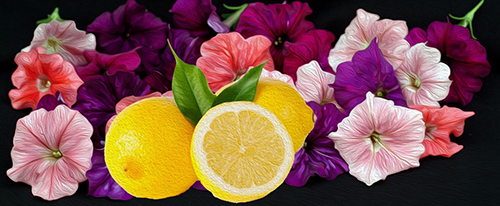Research highlight: Hyperacidification of Citrus fruits by a vacuolar proton-pumping P-ATPase complex
The vacuolar lumen of most plant cells is mildly acidic as compared to the surrounding cytoplasm, which is nearly neutral. In some plant tissues, however, vacuoles are extremely acidic. A few years ago, blue petunia flower mutants failing to hyper-acidify the vacuoles in their petals, revealed that petal cells are acidified by a different vacuolar proton transporter instead of the V-ATPase. The new pump is the heterodimer of a P3A-ATPase (PH5, very similar the plant cells plasma membrane H+-pump) and a P3B-ATPAses (PH1, similar to a bacterial Mg2+ transporter). The combination of these two proteins makes up a super-proton-transporter, which is able to acidify petal vacuoles to low pH. Because the pigments stored inside the petal vacuoles are pH indicators, when the PH1-PH5 pump does not work, color shifts from reddish to bluish.

The real challenge was, however, to understand how the most acidic plant cells get their pH. There was a long standing mystery about how lemon juice cells succeed in building a pH gradient between the neutral (pH~7) cytoplasm and the hyper-acidic (pH2) vacuolar lumen. In the University of Riverside, Mikael Roos and Clara Federici, have a collection of acidic wild varieties of citrus, as well as less acidic ones, like those that arrive on our tables. The hypothesis was that the same pump that makes petunia petals reddish acidifies citrus fruits. The comparison of the expression of PH1 and PH5 in a large set of sour and sweet varieties indeed showed that these genes are expressed in sour fruits and not in sweet ones. The PH5 proton pump is a more powerful transporter than the V-ATPase, using more than one ATP molecule for each translocated proton. Its combination with PH1 makes it able to keep on pumping when the proton gradient (and therefore also the electrochemical gradient) becomes steep, allowing the hyper-acidification of the lumen.
More surprisingly, the whole regulatory network that in petunia controls pigment production and vacuolar hyper-acidification is also perfectly conserved in citrus and the mutations selected during millennia of breeding of oranges, lemons, mandarins and pummelos are just a few different ones mostly in a transcription factor, called AN1. A few alleles of AN1 are found over and over again in different varieties of sweet fruits. Because AN1 is also required for the coloration of flowers and young leaves, most citrus plants producing sweet fruits display white flowers and green young shoots, while these are purplish in plants giving sour fruits. This might have provided a useful marker during ancient breeding programs.
The research, carried out at the UvA Plant Development and Epi-Genetics group (SILS-FNWI) including microscopy work at the van Leeuwenhoek Centre for Advanced Microscopy and was published in the Nature Communications (https://www.nature.com/articles/s41467-019-08516-3).
